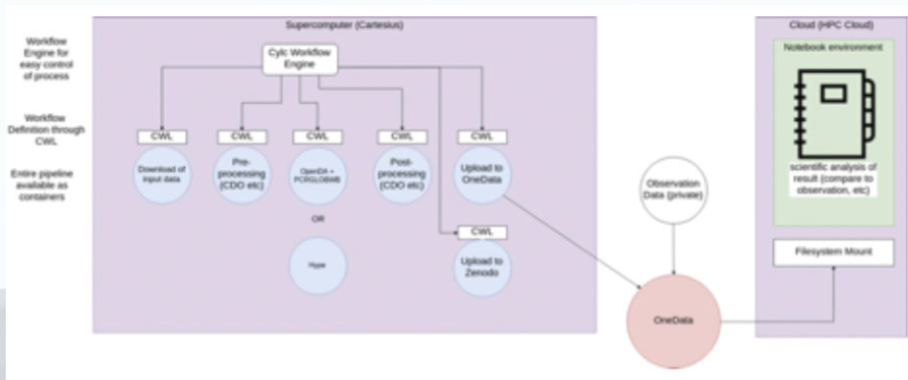|
SD ID: Switching on the EOSC for Reproducible Computational Hydrology by FAIRifying eWaterCycle and SWITCH-ON
Organisations & contacts Dr Berit Arheimer - SMHI Michael R. Crusoe - Common Workflow Language Dr Axel Berg - SURFsara Dr Sergio Andreozzi - EGI Foundation Dr Lukasz Dutka - CYFRONET Dr Anton Frank - Leibniz Supercomputing Centre (LRZ), Bavarian Academy of Sciences and Humanities Prof dr. ir. Nick van de Giesen - Delft University of Technology |
OVERVIEW: Central to the science of hydrology is the localized nature of the medium through which water flows. The science demonstrator proposal seeks to integrate the top-down approach of the eWaterCycle project with the bottom-up approach of the SWITCH-ON one.
SCIENTIFIC OBJECTIVES:
Central to the science of hydrology is the localised nature of the medium through which water flows. This science demonstrator seeks to create a fully FAIR Hydrological forecasting system, combining local and global models.
- FAIR Output Forecast dataset
- Fair Software for Hydrological Modelling
- Fair Workflows for Hydrological modelling on EOSC
- Community and Outreach
FAIR DATA CHALLENGES
- create FAIR versions of data required for running the hydrological models
- FAIR software (source code and ready-to-run software)
MAIN ACHIEVEMENTS
- We have worked on the FAIR data part of the project by making an overview of the FAIR-ness of each dataset we use and produce.
- Making 3rd party data FAIR is proving to be a challenge, as most of the time it is simply not up to us to distribute and/or publish data, and a lot of metadata is missing that we need the actual data author for to create and/or find. Also, determining if a dataset is FAIR, and how much, is currently something for “FAIR experts”.
- We worked making containerised versions of tools, libraries and execution environment to support 3 hydrological models, as well as tools for pre- and post-processing and data assimilation
- All this software has been provided on GitHub repository
- Not being enough to have all tools and models available, we also enabled a reproducible way of stringing these together, we used the Common workflow Language (CWL).
- Data sharing solution between two model established to OneData a storage provider.
- Reach out to the Hydrological community at key international events and workshops, like FAIR science EGU and OpenHydro meeting.

IMPACT
- facilitate model comparison studies, coupling of models and integration with different model components into larger community models
- benefits for the water community when it comes to run coupled models to do operational predictions
RECOMMENDATIONS FOR THE IMPLEMENTATION
Provide a number of basic services (such as Authentication, Dataset storage, workflow execution, dataset publication (DOIs) applicable for all of science.

